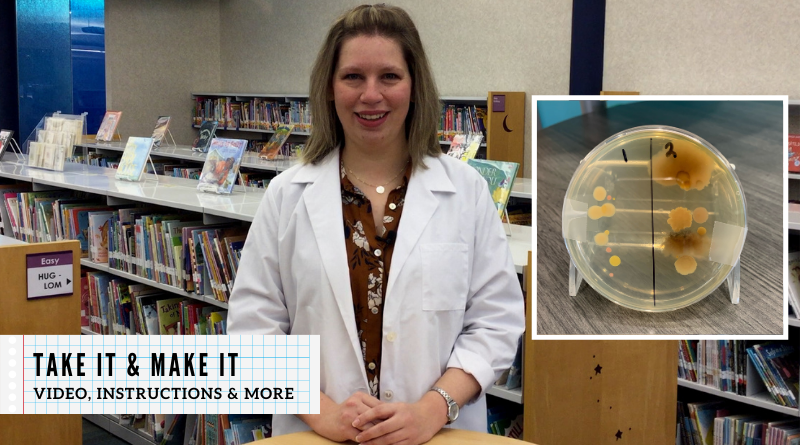
STEAM Connections: Bacteria
Bacteria is all around. Let’s take a look closer look at bacteria, explore the different types, and learn what is good bacteria versus bad bacteria. Then we will grow our own bacteria!
Content Overview
Bacteria are small, microscopic organisms, or living things, that can be found all around. They are so small that most bacteria can be seen only with a microscope. Some bacteria are good, like those found in the digestive system. And then there are bad bacteria that cause infections.
The study of bacteria falls under the field of microbiology. Microbiologists study microscopic organisms with help of a microscope.
Bacteria that cause diseases can get into the human body through the nose, the mouth, and cuts in the skin. Once inside, these bacteria quickly reproduce and cause illness, called an infection.
Some bacteria are good for our bodies — they help keep the digestive system in working order and keep harmful bacteria from moving in. Some bacteria are used to make medicines and vaccines. Bacteria are classified into three main groups according to their shape: spherical (cocci), rod (bacilli), and spiral (spirilla). They can exist as single cells, in pairs, chains or clusters.
Hands-On Exploration
For this experiment, we will be using a petri dish with nutrient agar to help grow bacteria you will collect from around your house, the car, or from a public place. After collecting samples and swabbing them to the petri dish. Then, track your results for 5 days to see how bacteria can continue to grow. Let’s get growing!
Safety Reminders:
- Use gloves when handling the petri dish especially after bacteria growth
- Do not open the petri dish cover after adding the sample and keep in the baggie because the dishes will get very smelly
Activity Demonstration and Supplies
Supplies
- Petri dish with agar*
- Ziplock bag that fits the dish
- Two cotton swabs
- Optional Add-Ons:
- Permanent marker
- Tape
*visit your favorite online store for petri dish with agar jelly!
Instructions
- In the petri dish, there is a substance called agar. Do not open your petri dish until you are ready to swab – the agar can dry out.
- On the bottom of the dish, draw a line dividing the dish in half. Label one side with “1” and the other side, “2.”
- Lightly wet one of your cotton swabs then rub the swab on a sample spot in your house, car, or public space.
- Lightly rub the sample on to the agar in a zig-zag over side 1.
- Lightly wet the second cotton swab then rub the swab on another sample spot in your house, car, or public space.
- Lightly rub that sample on to the agar in a zig-zag over side 2.
- Place the lid on the dish. To further secure the lid to the dish, tape it closed. Put dish into the Ziplock bag, turn upside down, and place in a warm space to incubate.
Record results: draw what you see growing on the petri dish after 1 day, 3 days, and 5 days.
Talk About the Activity
- Were the results surprising?
- Which sample had more bacteria growth?
- Do the two samples look different? Or similar?
- What would be the best way to stop bacteria growth?
When you’re finished with the experiment, with gloves and eye protection, add a few drops of bleach to the baggie. Seal the bag and dispose of it in the trash.
Continued Learning
The best way to combat bad bacterial infections is to wash your hands! First, wet your hands with warm water then Lather your hands with soap and scrub your hands for 20 seconds like the length of singing your ABC’s (at a normal speed, not so fast). And remember to scrub all parts of the hands because germs are good at hiding like in between the fingers. Rinse your hands under running water and dry your hands with a clean towel.
Check It Out
Below are resources (books, databases) available from the library and beyond to extend your learning about bacteria.
The Surprising World of Bacteria with Max Axiom, Super Scientist by Agnieszka Biskup
The Bacteria Book by Steve Mould
Science Kids: Bacteria (DVD)
You Wouldn’t Want to Live Without Bacteria! by Roger Canavan
Science in Context – GALE: contextual information on science topics showing how disciplines relate to real-world issues, from weather patterns to obesity. Search “bacteria” for some interesting results! This database is available to Plano Public Library cardholders.
Steve Spangler Science: Growing Bacteria in Petri Dishes
Purdue Science Experiment: Growing Bacteria Project: Child Development, Health, Foods, Microwave (PDF)
Be sure to check out our other hands-on experiments in the STEAM Connections tag here on the Plano Library Learns blog!




